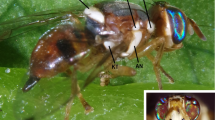Summary
Half-way through the larval period in Dacus tryoni, the fat body cells begin to accumulate protein in the form of granules. Early in the pupal period, both the fat body cells and oenocytes become free in the body cavity. Meanwhile, an imaginal generation of hypodermal cells, while in the process of displacing the larval hypodermis, gives rise to an imaginal generation of oenocytes. Soon after, imaginal fat body cells also appear. A few days after emergence, the larval fat body cells and oenocytes disintegrate and their imaginal equivalents expand to fill the body cavity.
This paper also describes the ultrastructure of the larval and imaginal fat body cells and of the imaginal oenocyte. In all three, tubular invaginations of the plasma membrane occupy the peripheral cytoplasm. At most stages, the fat body cells contain a considerable quantity of slightly distended, rough endoplasmic reticulum, which suggests that when these cells are not sequestering protein, they are secreting it into the blood. The imaginal oenocytes are packed with smooth endoplasmic reticulum, which supports other evidence that they participate in the synthesis of cuticular wax.
Similar content being viewed by others
References
Bodenstein, D.: The postembryonic development of Drosophila. In: Biology of Drosophila (M. Demerec ed.), p. 275–367, New York: John Wiley & Sons 1950.
Day, M. F.: The function of the corpus allatum in muscoid Diptera. Biol. Bull. 84, 127–140 (1943).
Evans, J. J. T.: The integument of the Queensland fruit fly, Dacus tryoni (Frogg.) I. The tergal glands. Z. Zellforsch. 81, 18–33 (1967a).
—: The integument of the Queensland fruit fly, Dacus tryoni (Frogg.) II. Development and ultrastructure of the abdominal integument and bristles. Z. Zellforsch. 81, 34–48 (1967b).
-, and P. J. Stanbury: The function of the tergal glands in the Queensland fruit fly, Dacus tryoni (Frogg.) III. Function of the tergal glands. In preparation (1967).
Fawcett, D. W.: The cell. Philadelphia and London: W. B. Saunders Co. 1966.
Gaudecker, B. von: Über den Formwechsel einiger Zellorganelle bei der Bildung der Reservestoffe im Fettkörper von Drosophila-Larven. Z. Zellforsch. 61, 56–95 (1963).
Ishizaki, H.: Electron microscopic study of changes in the subcellular organization during metamorphosis of the fat body cells of Philosamia cynthia ricini (Lepidoptera). J. Insect. Physiol. 11, 845–855 (1965).
Locke, M., and J. V. Collins: The structure and formation of protein granules in the fat body of an insect. J. Cell Biol. 26, 857–884 (1965).
Pérez, C.: Recherches histologiques sur la métamorphose des Muscides Calliphora erythrocephala Mg. Arch. Zool. exp. gén. (5e serie) 4, 1–274 (1910).
Shigematsu, H.: Synthesis of blood protein by the fat body in the silkworm, Bombyx mori L. Nature (Lond.) 182, 880–882 (1958).
Walker, P. A.: The structure of the fat body in normal and starved cockroaches as seen with the electron microscope. J. Insect. Physiol. 11, 1625–1631 (1965).
Wigglesworth, V. B.: The principles of insect physiology, 6th ed. London: Methuen & Co. 1965.
Author information
Authors and Affiliations
Additional information
For assistance with the electron microscopy, I thank Mr. Tony Webber and Miss Ann Miller of the Electron Microscopy Unit at Sydney University. For the loan of some sectioned material, I am grateful to Dr. D. T. Anderson.
Rights and permissions
About this article
Cite this article
Evans, J.J.T. Development and ultrastructure of the fat body cells and oenocytes of the Queensland fruit fly, Dacus tryoni (Frogg.). Zeitschrift für Zellforschung 81, 49–61 (1967). https://doi.org/10.1007/BF00344551
Received:
Issue Date:
DOI: https://doi.org/10.1007/BF00344551




